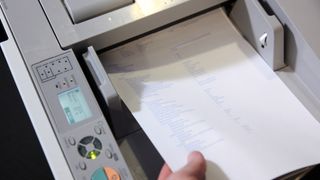Office printer: how to choose it and get more from it
From choosing a printer to managing the batches

We may have entered the digital age, but few businesses believe they can still get by without at least one printer. The size of the initial investment can vary widely, but over time printing can be a significant drain on the budget, and it's important to think about how you can best use your printers to support productivity and keep down the running costs.
The first step is ensure that you choose the right printer, or combination, for what you need. There are some basic questions to ask, as outlined in Dell's guide to choosing a work printer.
These include whether you need to print in colour or simply mono, if it needs to be combined with scan and copying features, whether you want it to work on a wired network or Wi-Fi, if there's a need to print faxes, and whether you want functions for auto feed and two sided printing. You might also ask if you want to print directly from a media card, camera or phone without having transfer data to an office PC.
Inkjet or laser?
There's also the choice between laser and inkjet, with the former usually being better for more complex jobs such as presentations and large spreadsheets.
You should also think about the number and combination of printers. The smallest office will probably make do with a single multi-function printer, but larger firms may be better served by having one or two mono printers for simple internal jobs and more sophisticated machines for documents they want to present outside.
Most of the costs in printing come from replacing the toners or cartridges, so it's always useful to look at minimising the amount of ink used. It's worth setting black and white or greyscale as the default mode, using colour only for important documents, and even using draft mode for jobs that are only for internal consumption.
Printing on both sides of the paper can also reduce costs, and it can impress clients who are concerned about environmental issues.
Get daily insight, inspiration and deals in your inbox
Get the hottest deals available in your inbox plus news, reviews, opinion, analysis and more from the TechRadar team.
It's also worth keeping an eye open for broken print on documents in a print run. This indicates that the print head is becoming dirty, and if it goes unchecked could require some expensive cleaning. Models that have a maintenance tab should include a head cleaning and nozzle check function that deals with this before it gets out of hand.
Batch savings
Another area that can provide savings is to programme the software to print in batches rather than immediately for every job. This is because laser printers have to warm up and inkjets lubricate their print heads, so if a number of jobs are sent through together it can save on start-up and cool-down procedures.
Against this you have to have to allow scope for the urgent jobs to go through immediately, and there's likely to be a judgement call in how much flexibility you allow for people to override any batch printing programme.
In addition, some printers clean their print heads every time they turn on, which can waste ink. If possible it's often worth turning off this function and only turning it on when printing large quantities.
As a company gets larger and takes on more printers their management becomes more sophisticated; you can schedule alternate printer times and assign priority levels for different workgroups, and programme the system to direct more expensive jobs to the more efficient printers. The trick with this is to ensure it reflects the workflows within a company and the urgency with which different people have to print material.
With all of this, the best results will come when everyone in the company is aware and the approach and follows it. A good printer management policy can make an important contribution to the IT optimisation of a small business.
